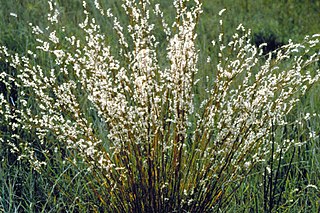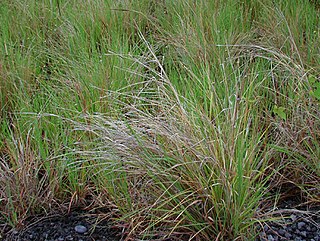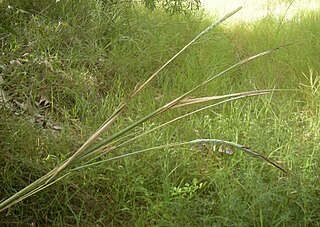
The Andropogoneae, sometimes called the sorghum tribe, are a large tribe of grasses (family Poaceae) with roughly 1,200 species in 90 genera, mainly distributed in tropical and subtropical areas. They include such important crops as maize (corn), sugarcane, and sorghum. All species in this tribe use C4 carbon fixation, which makes them competitive under warm, high-light conditions.

Heteropogon contortus is a tropical, perennial tussock grass with a native distribution encompassing Southern Africa, southern Asia, Northern Australia, Oceania, and southwestern North America. The species has also become a naturalised weed in tropical and subtropical regions in the Americas and East Asia. The plant grows to 1.5 metres (4.9 ft) in height and is favoured in most environments by frequent burning. The plants develop characteristic dark seeds with a single long awn at one end and a sharp spike at the other. The awn becomes twisted when dry and straightens when moistened, and in combination with the spike is capable of drilling the seed into the soil.

Triprion spatulatus is a species of frog in the family Hylidae. It is endemic to the Pacific lowlands of western Mexico between the Sinaloa and Oaxaca states. It is known by several common names: shovel-headed treefrog, Mexican shovel-headed treefrog, shovel-nosed tree frog, and shovelhead treefrog.
Craugastor spatulatus is a species of frog in the family Craugastoridae. It is endemic to Mexico and known from Cuautlapam in central Veracruz and Vista Hermosa in the Sierra Juárez, Oaxaca. Its natural habitat is cloud forest. This formerly abundant species has strongly declined because of habitat loss, although other factors may have been involved too.

The racket-tailed roller is a species of bird in the family Coraciidae. It is found in southern Africa from Angola, south-eastern Democratic Republic of Congo and southern Tanzania to northern Botswana, Zimbabwe, Malawi and Mozambique.
The Bot River klipfish is a species of clinid endemic to South Africa where it is found in brackish waters of the Bot River and the Kleinmond Estuary where it lives amongst weeds. This species can reach a length of 17.5 centimetres (6.9 in) TL.

Heteropogon is a genus of annual and perennial plants in the grass family known generally as tangleheads, widespread primarily in tropical and subtropical regions.

Heteropogon triticeus is a tropical, perennial tussock grass with a native distribution encompassing Tropical and Temperate Asia, Malesia and Northern and Eastern Australia. The plant grows to over 2 metres (6.6 ft) in height and is favoured in most environments by frequent burning. The plants develop characteristic dark seeds with a single long awn at one end and a sharp spike at the other. The awn becomes twisted when dry and straightens when moistened, and in combination with the spike is capable of drilling the seed into the soil.

Capnobotes is a North-American genus of shield-backed katydids in the family Tettigoniidae. There are about 9 described species in Capnobotes.
Heteropogon macerinus is a species of robber flies in the family Asilidae.
Heteropogon is a genus of robber flies in the family Asilidae. There are at least 60 described species in Heteropogon.
Heteropogon phoenicurus is a species of robber flies in the family Asilidae.
Heteropogon duncani is a species of robber flies in the family Asilidae.
Heteropogon cirrhatus is a species of robber flies in the family Asilidae.
Heteropogon patruelis is a species of robber flies in the family Asilidae.
Capnobotes spatulatus, the spatulate longwing, is a species of shield-backed katydid in the family Tettigoniidae. It is found in North America.
Heteropogon lautus is a species of robber flies in the family Asilidae.
Cryptocarenus is a genus of typical bark beetles in the family Curculionidae. There are more than 20 described species in Cryptocarenus.
Heteropogon davisi is a species of robber flies in the family Asilidae.







